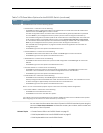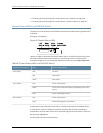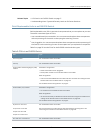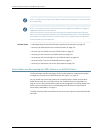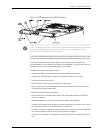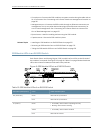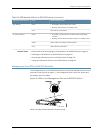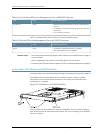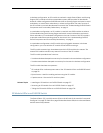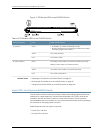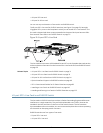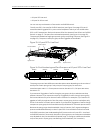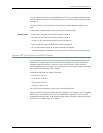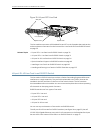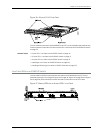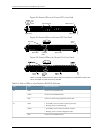
In the base configuration, an SF module is used with a single Switch Fabric and Routing
Engine (SRE) module to build a nonredundant system that provides full bandwidth.
However,a baseconfiguration EX8208 switchhas no RoutingEngine and switch control
redundancy or switch fabric redundancy. In a base configuration, the main function of
theSF moduleis toswitchdata between linecards.See“UnderstandingEX8208 Switch
Component and Functionality Redundancy” on page 11.
In a redundant configuration, an SF module is used with two SRE modules to achieve
full bandwidth along with Routing Engine and switch control redundancy and switch
fabric redundancy. In a redundant configuration, the main function of the SF module is
to provide a redundant switching plane for the switch. See “Understanding EX8208
Switch Component and Functionality Redundancy” on page 11.
In a redundant configuration, the SF module is hot-pluggable. However,in the base
configuration, you must take the SF module offline before removing it.
The SF module contains logic that determines which SRE module is the master.The
master SRE module controls many internal functions of the SF module.
The SF module provides these functions:
•
Provideredundantdatapathconnectivityfortheswitchintheredundantconfiguration
•
Provide nonredundant data path connectivity for the switch in the base configuration
The SF module has these components:
•
SF moduleLEDs—Indicatesystem status.See“SF ModuleLEDs in an EX8208 Switch”
on page 29.
•
Ejector levers—Used for installing and removing the SF module.
•
Captive screws—Secure the SF module in place.
Related Topics Installing an SF Module in an EX8208 Switch on page 157•
• Removing an SF Module from an EX8208 Switch on page 217
• Takingthe SF Module Offline in an EX8208 Switch on page 216
SF Module LEDs in an EX8208 Switch
TheSwitchFabric (SF)modulehastwoLEDs ontheleftsideof themodule’sfrontpanel.
SeeFigure11onpage30.Table13onpage30describestheseLEDs,theircolorsandstates,
and the status they indicate.
29Copyright©2010,Juniper Networks, Inc.
Chapter2:ComponentDescriptions



